The Intel Xeon W-3175X Review: 28 Unlocked Cores, $2999
by Ian Cutress on January 30, 2019 9:00 AM ESTCPU Performance: Rendering Tests
Rendering is often a key target for processor workloads, lending itself to a professional environment. It comes in different formats as well, from 3D rendering through rasterization, such as games, or by ray tracing, and invokes the ability of the software to manage meshes, textures, collisions, aliasing, physics (in animations), and discarding unnecessary work. Most renderers offer CPU code paths, while a few use GPUs and select environments use FPGAs or dedicated ASICs. For big studios however, CPUs are still the hardware of choice.
All of our benchmark results can also be found in our benchmark engine, Bench.
For our graphs, some of them have two values: a regular value in orange, and one in red called 'Intel Spec'. ASUS offers the option to 'open up' the power and current limits of the chip, so the CPU is still running at the same frequency but is not throttled. Despite Intel saying that they recommend 'Intel Spec', the system they sent to us to test was actually set up with the power limits opened up, and the results they provided for us to compare to internally also correlated with that setting. As a result, we're providing both sets results for our CPU tests.
Corona 1.3: Performance Render
An advanced performance based renderer for software such as 3ds Max and Cinema 4D, the Corona benchmark renders a generated scene as a standard under its 1.3 software version. Normally the GUI implementation of the benchmark shows the scene being built, and allows the user to upload the result as a ‘time to complete’.
We got in contact with the developer who gave us a command line version of the benchmark that does a direct output of results. Rather than reporting time, we report the average number of rays per second across six runs, as the performance scaling of a result per unit time is typically visually easier to understand.
The Corona benchmark website can be found at https://corona-renderer.com/benchmark
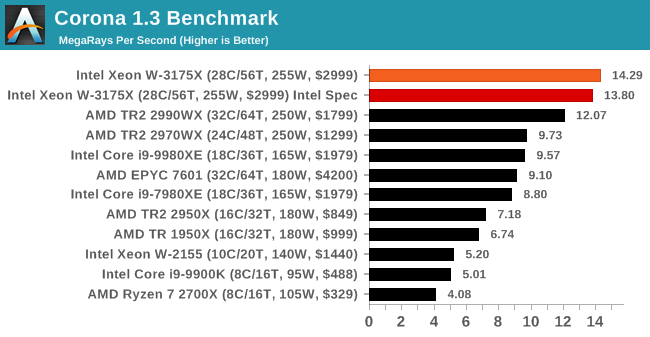
.
Blender 2.79b: 3D Creation Suite
A high profile rendering tool, Blender is open-source allowing for massive amounts of configurability, and is used by a number of high-profile animation studios worldwide. The organization recently released a Blender benchmark package, a couple of weeks after we had narrowed our Blender test for our new suite, however their test can take over an hour. For our results, we run one of the sub-tests in that suite through the command line - a standard ‘bmw27’ scene in CPU only mode, and measure the time to complete the render.
Blender can be downloaded at https://www.blender.org/download/
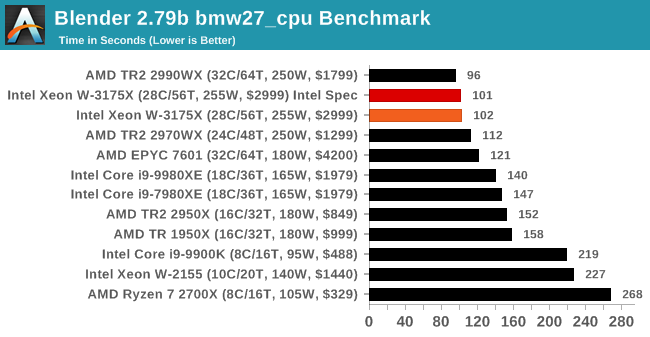
.
LuxMark v3.1: LuxRender via Different Code Paths
As stated at the top, there are many different ways to process rendering data: CPU, GPU, Accelerator, and others. On top of that, there are many frameworks and APIs in which to program, depending on how the software will be used. LuxMark, a benchmark developed using the LuxRender engine, offers several different scenes and APIs.
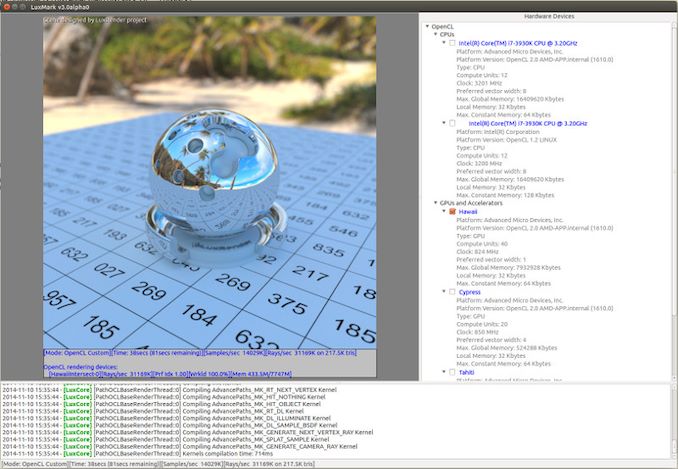
Taken from the Linux Version of LuxMark
In our test, we run the simple ‘Ball’ scene on both the C++ and OpenCL code paths, but in CPU mode. This scene starts with a rough render and slowly improves the quality over two minutes, giving a final result in what is essentially an average ‘kilorays per second’.
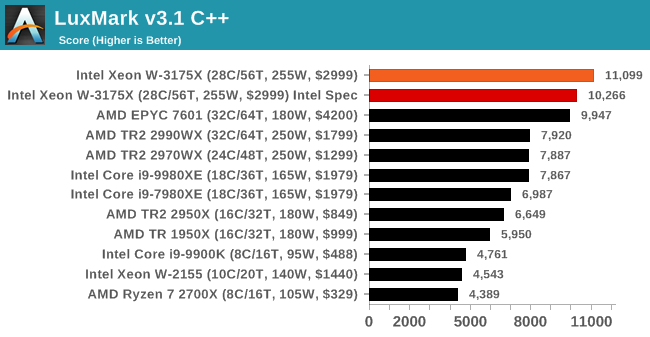
.
POV-Ray 3.7.1: Ray Tracing
The Persistence of Vision ray tracing engine is another well-known benchmarking tool, which was in a state of relative hibernation until AMD released its Zen processors, to which suddenly both Intel and AMD were submitting code to the main branch of the open source project. For our test, we use the built-in benchmark for all-cores, called from the command line.
POV-Ray can be downloaded from http://www.povray.org/
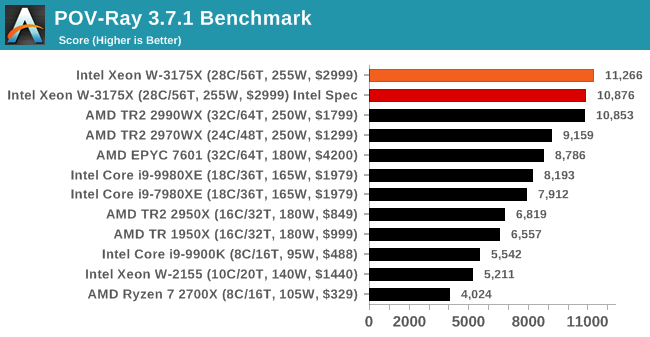
.











136 Comments
View All Comments
FMinus - Friday, February 1, 2019 - link
Not really, 3D rednering is done on specialized render farms, the modeling work, key framing etc. can be done on any decent modern mainstream CPU, and especially well on any modern HEDT chip, for prototyping and preview, once satisfied, send it out to render properly.eastcoast_pete - Wednesday, January 30, 2019 - link
The only scenario where this or similar Xeons do outperform the AMD lineup is if (!) the key application (s) in question make good use of AVX512. In those situations, Intel is still way ahead. In all others, a similar or lower priced Threadripper will give more bang for the buck.Tango - Wednesday, January 30, 2019 - link
There are scenarios in which this is perfect, and in fact my research department is looking into acquiring two of them. Our algorithms include both highly parallelized instructions and completely non parallelizable ones where clock speed dominates. We estimate models that take a whole weekend to spot out a result, and the alternative is paying top money for supercomputer time.At $3000 it is a steal. The problem is half Wall Street will be sending orders to get one, since the use case is similar for high frequency trading applications.
MattZN - Wednesday, January 30, 2019 - link
I expect all the review sites will redo their 2990WX benchmarks once Microsoft is able to fix the scheduler. The question is really... how long will it take Microsoft to fix their scheduler? That said, nobody should be expecting massive improvements. Some of the applications will improve a ton, but not all of them. It will be more like a right-sizing closer to expected results and less like hitting the ball out of the park.-Matt
BGADK - Wednesday, January 30, 2019 - link
Little professional software exists for Linux, so these machines WILL run windows for most parts.cmcl - Thursday, January 31, 2019 - link
Agree that there is more professional software for Windows, but in visual effects (where I work), 90% of our workstations (and all render) runs on Linux (24-core workstations, with P6000s), running Nuke, Maya etc. Apart from the gaming benchmarks (and who would buy one of these for gaming), a lot of the tests could be done in Linux as that software runs on LinuxIcehawk - Thursday, January 31, 2019 - link
Workstations aside, these mega-core beasts are run as VM hosts on bare metal. I don't have a single server here that just runs an OS & app suite, it's not 2000 anymore everything is virtualized as much as possible.WasHopingForAnHonestReview - Wednesday, January 30, 2019 - link
Holy shit. AMD absolutely bent intel over on this one. The price for performance ratio is overwhelming in AMD ls favor! Intel would have released this for 8k if the 2990wx wasnt so competitive!WOW!
GreenReaper - Thursday, January 31, 2019 - link
They probably wouldn't have released it at all. As noted, most of these could easily be server cores on which they could make plenty more money. This appears to be largely a PR effort.jcc5169 - Wednesday, January 30, 2019 - link
Who in the world would buy this over-priced piece-of-crap?